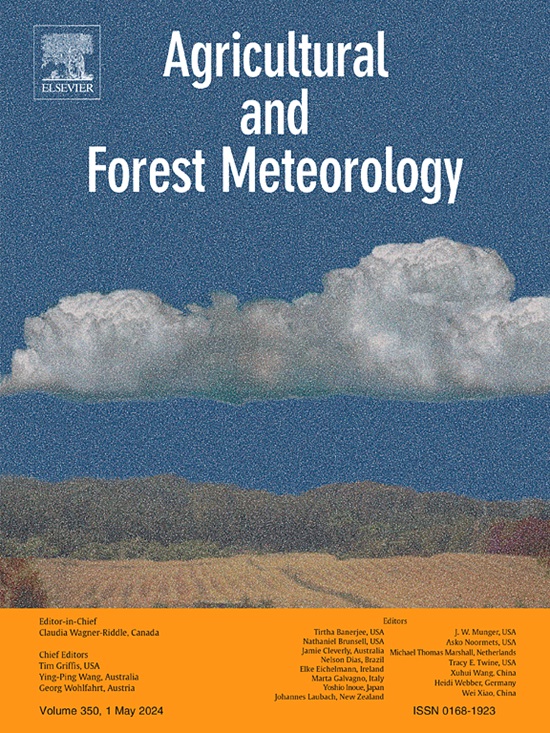城市树木在生长季节的建筑变化和水的限制显著地促进了气候服务的变化
IF 5.6
1区 农林科学
Q1 AGRONOMY
引用次数: 0
摘要
行道树因改善城市热舒适而受到关注,但树木服务与树木建筑演变的季节性变化尚未得到很好的理解。这项研究假设,在一个生长季节和晴天,气候服务的变化主要依赖于树木结构对阴影的影响,特别是在夏季干旱期间。在一个缩小规模的街道峡谷中种植了两排观赏苹果树,并设置了一个无植被控制区。在2022年7月5日之前,所有的树木都得到了充足的水分,之后一组树木受到了适度的水分限制,而另一组树木则保持了充足的水分。研究了街道小气候特征,计算了通用热气候指数(UTCI),测量了器官尺度和树冠尺度上的树木构型。在阳光明媚的日子里,水分充足的树木将热舒适从5月中旬的5.8°C UTCI提高到8月下旬的7.9°C,而用水限制在8周后将这种好处降低了2.7°C UTCI。热舒适的变化主要与树木建筑的发展和阴影有关,尽管这些影响是温和的,因为5月份叶面积指数足够高,可以确保87.5%的辐射拦截。树冠投影面积和体积的增加增强了树木的服务功能,对侧边的影响大于树冠下的影响。水分限制通过抑制茎的生长和加速叶片的脱落来降低热舒适,从而减少光拦截。本研究强调了水分限制下建筑可塑性在树木气候服务中的重要作用,值得在其他物种中进一步研究。本文章由计算机程序翻译,如有差异,请以英文原文为准。


Urban tree architectural modifications over the growing season and water restriction significantly contribute to variations in climate services
Street trees have gained attention for improving thermal comfort in cities, yet seasonal changes in tree services in relation to the evolution of tree architecture are not well understood. This study hypothesizes that over a growing season and for sunny days, changes in climate services primarily rely on tree architecture influence on cast-shadow, especially during summer droughts. Two alignments of ornamental apple trees were grown in a reduced-scale street canyon, with a non-vegetated control zone. All trees were well watered until July 5th, 2022, after which one alignment experienced moderate water restriction while the other remained well-watered. The street microclimate was characterized, the universal thermal climate index (UTCI) calculated, and tree architecture at the organ and crown scales was measured. On sunny days, well-watered trees improved thermal comfort from 5.8°C UTCI in mid-May to 7.9°C in late August, while water restriction reduced this benefit by up to 2.7°C UTCI after 8 weeks. The changes in thermal comfort were primarily linked to tree architectural development and cast-shadow, although these effects were moderate due to leaf area index high enough in May to ensure 87.5 % of interception of radiation. Increases in crown projected area and volume enhanced tree services, with larger effects on the side than just below the tree canopy. Water restriction diminished thermal comfort by inhibiting stem growth and accelerating leaf fall, thus reducing light interception. This study highlights the significant role of architectural plasticity in tree climate services under water restriction, warranting further research in other species.
求助全文
通过发布文献求助,成功后即可免费获取论文全文。
去求助
来源期刊
CiteScore
10.30
自引率
9.70%
发文量
415
审稿时长
69 days
期刊介绍:
Agricultural and Forest Meteorology is an international journal for the publication of original articles and reviews on the inter-relationship between meteorology, agriculture, forestry, and natural ecosystems. Emphasis is on basic and applied scientific research relevant to practical problems in the field of plant and soil sciences, ecology and biogeochemistry as affected by weather as well as climate variability and change. Theoretical models should be tested against experimental data. Articles must appeal to an international audience. Special issues devoted to single topics are also published.
Typical topics include canopy micrometeorology (e.g. canopy radiation transfer, turbulence near the ground, evapotranspiration, energy balance, fluxes of trace gases), micrometeorological instrumentation (e.g., sensors for trace gases, flux measurement instruments, radiation measurement techniques), aerobiology (e.g. the dispersion of pollen, spores, insects and pesticides), biometeorology (e.g. the effect of weather and climate on plant distribution, crop yield, water-use efficiency, and plant phenology), forest-fire/weather interactions, and feedbacks from vegetation to weather and the climate system.

 求助内容:
求助内容: 应助结果提醒方式:
应助结果提醒方式:


